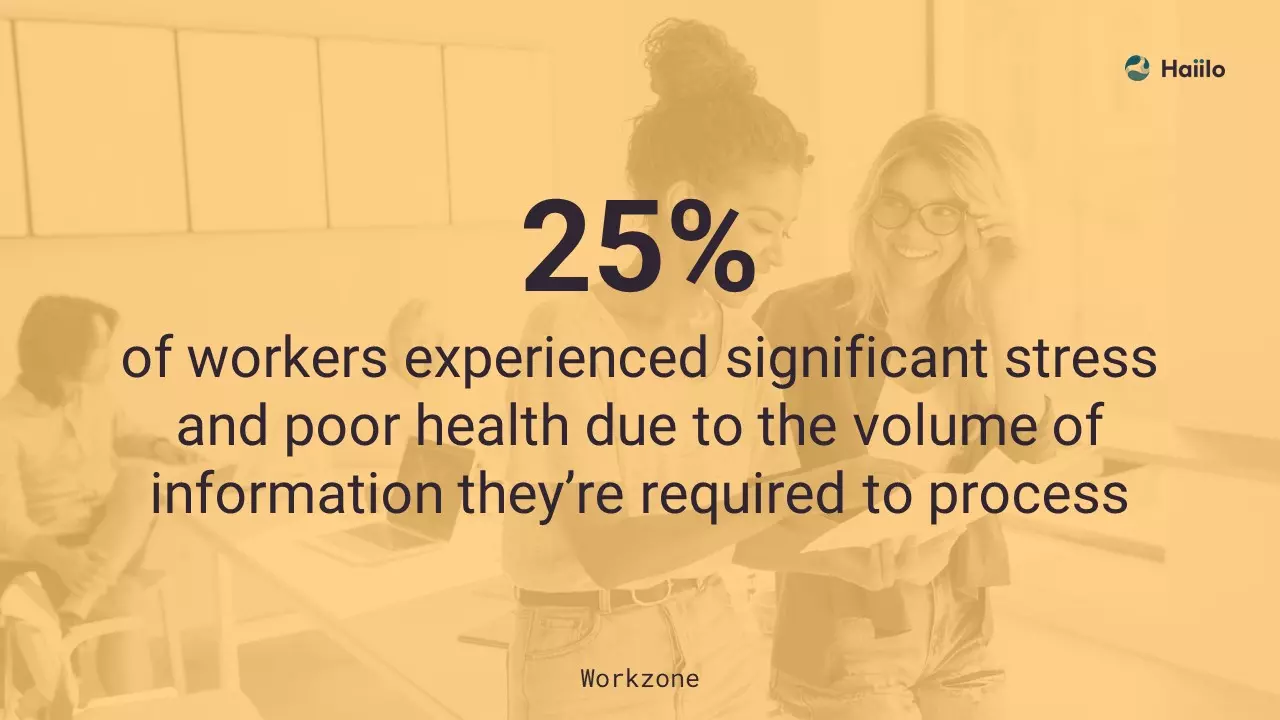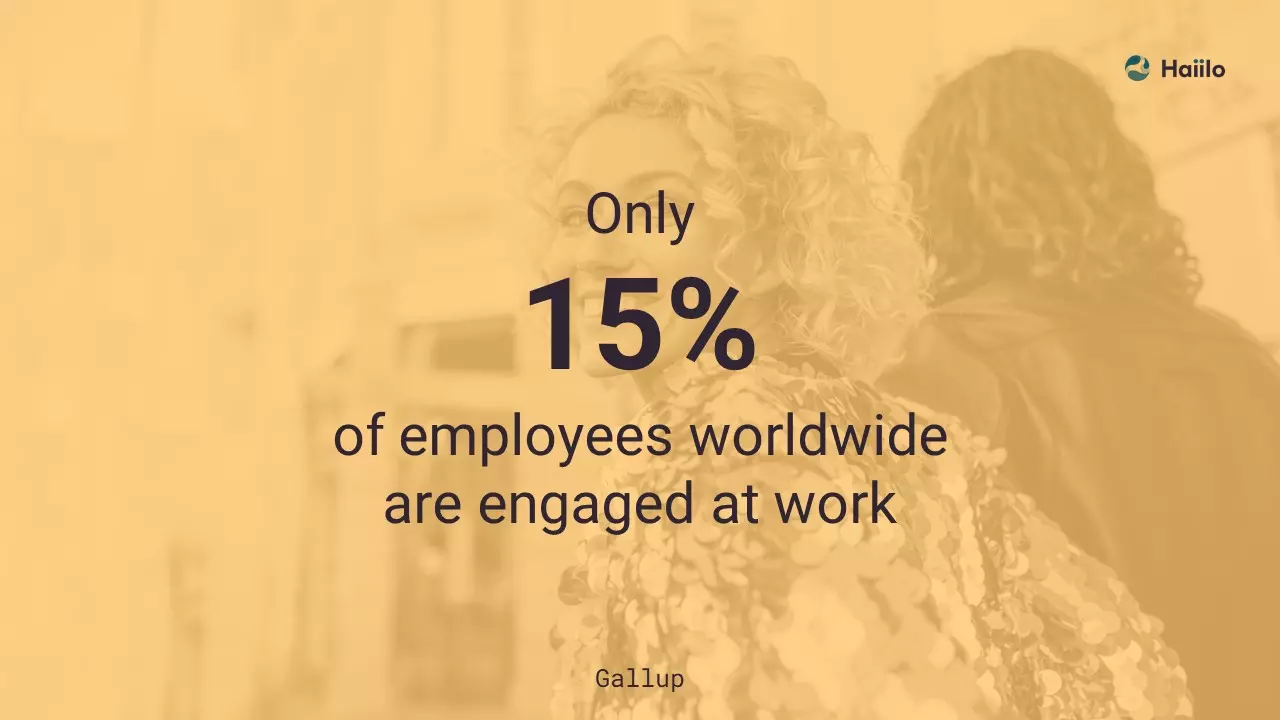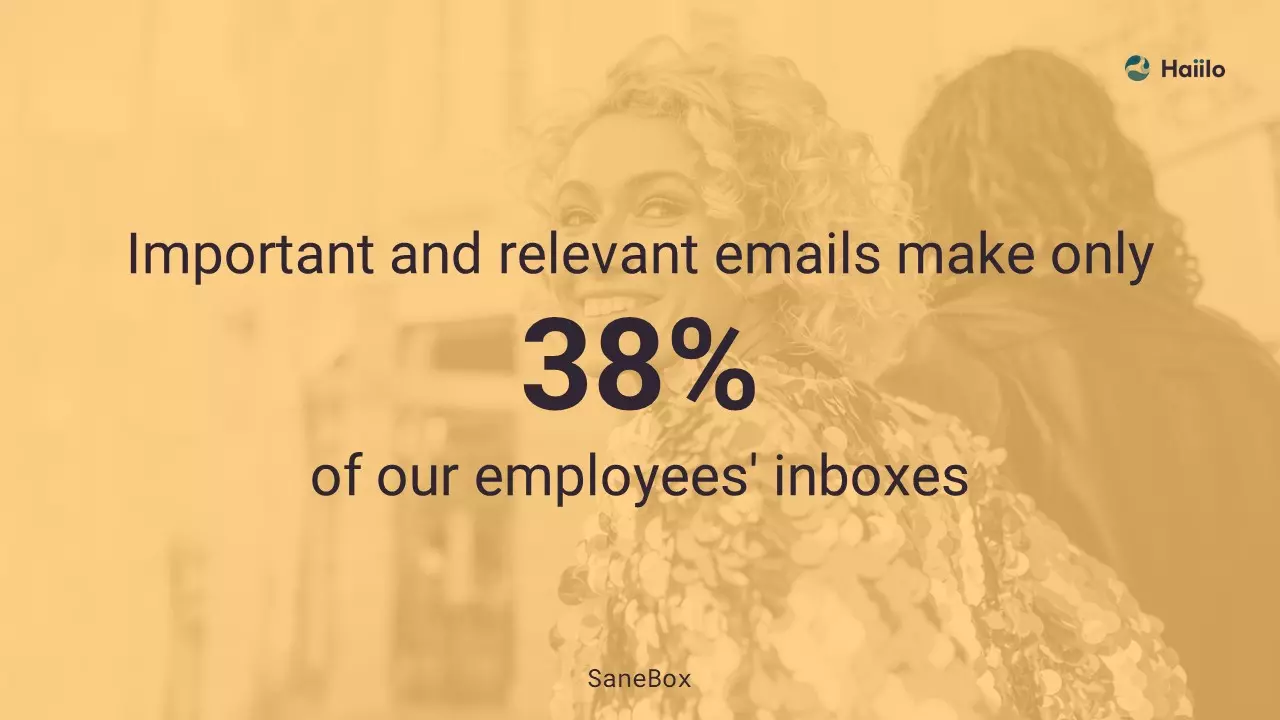Information overload is a growing challenge for organizations across the world while improving employee experience (EX) is a top priority for most businesses. However, 36% of managers say they’re suffering from poor health due to the excessive amount of information they have to process at work.
The thing is, even though information overload is a well-known challenge, it seems that most businesses haven’t found the right solutions to stop it yet, which is quite alarming.
Think about it: a recent Gallup study of 7,500 full-time employees found that 44% reported feeling burned out. Ouch!
Get rid of information overload by distributing the right information to the right people at the right time
Not only does information overload affect your employees’ health and well-being, but it also impacts their performance at work, your ability to attract and retain top talent as well as your brand reputation. At the end of the day, it’s your entire business that may suffer from information overload.
So, what actually causes information overload in the workplace, and how to stop it?
Let’s find out in this blog!

The Definition of Information Overload
Information overload in the workplace is a term used to describe the extensive amount of irrelevant information flowing among employees.
It’s hard to avoid information overload in today’s workplace. Most businesses, from startups to large organizations are dealing with information overload. Moreover, this trend is continuously growing both in employees’ private and professional lives.
Think about it: in a recent study, 65,2% of UK employees said that their work is negatively impacted by the high amount of data they have to process at work.
What’s more, 91% of US workers admit that they sometimes delete or discard work-related information without fully reading it!
The thing is, most employees have to deal with excessive amounts of information and data every day at work.
Unsurprisingly, this type of situation comes at a cost: information overload costs the US economy a minimum of $900 billion per year in lowered employee productivity and reduced innovation, according to recent research by Basex, which specializes in technical issues in the workplace. Ouch!
📹 Information overload is one of the biggest communication barriers in the workplace. Check out our Masterclass to learn how to tackle other barriers.
What Causes Information Overload in the Workplace?
There is some misleading about the causes of information in the workplace. In essence, the term “overload” refers to “too much of something”. By “information overload”, you usually mean the overwhelming data employees are dealing with in their daily jobs.
However, the amount of data employees are processing at work is not the only issue most businesses are facing in today’s fast-changing work environment. Indeed, information overload is also caused by irrelevant information shared with employees.

So, when you refer to information overload, you actually refer to the volume of information exchanged in the workplace as well as the poor quality of information shared with employees. And “poor quality of information” means information that is not relevant to them.
Basically, information overload is strongly connected with:
- Too much information shared in the workplace
- Irrelevant information exchanged at work
- A lack of alignment between all the discussions going on at the same time in the workplace
- Not enough time given to the employees to process the information they receive
- A lack of alignment and strategic vision in the workplace
📙 Read more about why content localization is important in internal communications.
How Information Overload Impacts Your Business?
Information overload impacts your business at three levels: your employees, your teams and the organization overall.
At the end of the day, it’s your employees’ experience and the business’s bottom line that is affected by information overload! According to research, information overload can have many negative sides such as:
- Employee productivity
- Employee satisfaction
- Workplace collaboration
- Employer brand
- Business performance
- Workplace relationships
- Innovation and agility
- Workplace safety
- Organizational alignment
- Crisis management
- Change management
Let’s now take a deeper look into some of the most significant consequences of information overload in the workplace:
1. It Affects Your Employees’ Health and Well-Being
Plenty of research has shown the negative impacts of information overload in the workplace on employees’ wellbeing and health.
The stats are choking and alarming:
- 25% of workers experienced significant stress and poor health due to the volume of information they’re required to process.
- 36% of managers reported poor health due to the excessive information they were required to process in the workplace.
- 68% of those managers felt that information overload has had a negative impact on their personal and professional relationships.

So, what happens when an employee feels overwhelmed with excessive amounts of and/or irrelevant information in the workplace?
Essentially, employees dealing with information overload feel stressed out, anxious and they may have trouble sleeping at night. And most of them feel they have reached the point of burnout: Gallup found that 23% of employees feel burned out at work very often or always, while an additional 44% feel burned out sometimes.
Another study by Burton Group found that:
- 42% of IT managers complain that they are bombarded by too much information
- 39% can’t figure out which information is accurate
- 21% don’t understand the value of the information they receive.
Unsurprisingly, information overload has a direct impact on employees’ health as well as their personal and professional relationships as mentioned above.
2. It Kills Your Employees’ Performance and Productivity
An interesting survey shows that employees deal with roughly 115 emails per day and yet, they miss out on one-third of the information exchanged through emails.
Broadly speaking, employees spend on average 2.5 hours per day looking for the information they need to do their jobs.

That means that employees spend on average one-third of their time trying to find the information they need to complete their tasks. They browse their G-suite, call their colleagues for help or run to another department to ask for the missing information in person. This way of working is far from being effective!
Related: Top 15 Employee Motivation Tips and Benefits
What’s more, recent studies have shown that people are distracted almost every 3 minutes and 5 seconds by the buzzing of their phones of a new message or email. Each distraction takes another 23 minutes and 15 seconds on average to refocus on the task at hand.
How can your employees deliver a great performance when they’re dealing with multiple communication channels, have to look for the information they need and are interrupted in their work every 3 minutes?
Let’s be honest, they literally can’t do their job properly in those conditions.
Not only does information overload slow down your employees’ productivity, it also impacts their ability to make timely decisions. They feel confused, stressed out, frustrated, and naturally start making mistakes. Simply put, information overload shuts our brains down!
The way information overload affects our brains and ability to make decisions is a bit complex, but The Brief Lab made this complex idea easy to understand for everyone.
Here’s what they said:
“As the amount of information and options they have to consider increased beyond their limit, brain activity suddenly fell off as if there was a short circuit. It’s like exercising until the point of exhaustion. Once your body is maxed out, it shuts down”.
3. It Lowers Team Performance
Even though you have the best talent in-house, you won’t be able to build skyrocketing teams if your internal communication isn’t effective because yes, information overload does impact your teams’ performance!

What do all successful teams have in common? Great communication.
Each team member knows what the other team members are working on, and they know how their works are interconnected. They know what’s expected from them and how their work impacts the team’s performance and the business’s bottom line. And most importantly, they know where to find the information they need!
Read on: Team Communication — Key Takeaways from Google’s Project Aristotle
Because of information overload, employees miss out on important information. As a result, team performance goes down because of overlapping, missed deadlines, and lack of alignment within the team!
4. It Affects Your Employer Brand and Business’ Bottom Line
As mentioned earlier, information overload — meaning ineffective internal communication — costs organizations a lot of money every year!
Remember, the economic losses due to information overload in the workplace are estimated to reach $900 billion a year in the US!
Because of misalignment, confusion and lower employee performance, your customer service team won’t able to provide the best customer service ever, your Marketing team won’t deliver awesome campaigns and your IT team won’t release new product features on time. That’s how you can start losing billions-worth deals! Momentum is extremely important in business and when you lose it, you just lose it, you can’t get it back!
But the loss caused by information overload goes beyond money.
Employees’ frustrations and confusion impact the work atmosphere in general.
Your courageous employees will start complaining about poor internal communication and collaboration in the workplace, they may start spreading the word outside the company and even start looking for a new company to join! There’s no way this kind of situation will end positively for you!

If you want to attract and retain top talent, you’ll need to make sure that your employees aren’t drowning in excessive amounts of information!
Read on: 8 Employee Engagement Statistics You Need to Know in 2022 [INFOGRAPHIC]
5 Ways to Stop Information Overload
Eliminating information overload in the workplace is very hard, but with the right internal comms strategy and tools in place, you can manage to drastically reduce it in no time!
Moreover, many organizations are now looking for new ways to better streamline the flow of information in their workplaces and make their workforce happier and more productive.
We share below 5 tips and tricks that will help you considerably improve your internal comms so you can make your employees’ lives much easier.
1. Use the Right Communication Channels
One of the main sources of information overload in the workplace is the impressive amount of communication channels that businesses are using nowadays to communicate with their employees.
In most organizations, employees are dealing with their company emails, project management tools, company newsletters, private messaging apps, document sharing tools, video conferencing software, internal company blogs and the list goes on.
Let’s be honest — with all these channels used simultaneously, it becomes harder and harder for employees to catch up with all the conversations (if those are relevant and insightful) going on within the organization!
But the real problem here isn’t that much the number of communication channels used in the workplace.
The #1 issue when it comes to information overload is the lack of coordination between all these discussions going on within the company.
All of these employee apps have different purposes and you may need to keep using all of them. Thus, you may not want to stop using some of them but what you can do instead is finding a way to better coordinate all the communication channels you’re using at your workplace.
Read on: Top 5 Communication Skills and How to Improve Them
To make your employees’ lives easier, you may want to have a central place where your employees — including your remote and deskless employees — can easily find all the latest company news and all the information they need to do their jobs.
So, besides using several communication channels such as newsletters and internal company blogs, consider providing employees with a single news feed where they can access tailored information through their preferred channels and devices. It’s that simple!
2. Forget About One-Size-Fits-All Communications
Did you know that 2 in 3 employees ignore your emails?
Well, now you know it!
The thing is, employees won’t read your messages if they think it’s irrelevant to them.

And this is what happens when you share standardized messages through email newsletters that you send to your entire workforce for example.
We tend to be irritated when we receive irrelevant content in our social news feed, right?
The same goes for your employees.
They don’t want to feel they’re wasting their time dealing with information they’re not interested in or content that doesn’t resonate with them.
One of the best ways to reduce information overload is to segment your content based on the topics you cover, your employees’ roles within the organization, their locations as well as the languages they speak, so you can share with them content that resonates with them.
Related: 5 Employee Communication Predictions for 2020 (And Beyond)
Basically, you would need to use an employee comms app that your employees would use in a similar way as they’d be using a news app, such as the BBC news app.
Think about it: news are arranged by topics, previews make it easy for you to read the headlines so you can make a quick selection of the articles you want to read, and you can customize your news feed based on the topics you want to be informed about.
That’s the reason why we’ve built Haiilo Stories — we want all employees (office-based and remote) to be able to easily find the information they need and customize their news feed. It’s all about putting employee experience first!
3. Rethink Your Company Culture
Do you develop a company culture where you put employees’ well-being first and don’t push multitasking too far? Do you give your employees a chance to share their feedback regarding your internal communication and most importantly, do you encourage dialogues at your workplace?
Read on: Company Values: Definition, Importance and Examples
When it comes to information overload, the issue is usually not only related to the volume and quality of information exchanged in the workplace.
It usually starts with your company culture.
No matter how effective your internal communication is, you won’t be able to tackle information overload without the right company culture in place. So, if you want to improve employee experience, make sure you rethink your company culture first!
Read on: Change Management: Definition, Best Practices & Examples
4. Get Top Management on Board
When it comes to tackling information overload and thus changing your internal comms, you need to get top management and leadrship on board.
You can’t expect to improve your employee communications and internal processes if top management doesn’t support the initiative or if the leaders lack good leadership skills. But they’ll also need to act upon it. That means they should make employee experience their #1 priority.
Indeed, information overload isn’t just a communication problem that hurts your business. It’s bigger than that.
As mentioned earlier, information overload has negative impacts on employees’ performance, concentration, ability to make decisions and most importantly, their health and well-being. Information overload can literally destroy your employees’ health. As mentioned earlier, recent surveys have shown that screen fatigue — or digital overload — is a key factor of burnout.
Actions speak louder than words so it’s important to make sure that top management takes concrete initiatives and supports your IC strategy to tackle information overload at your workplace!
5. Assess Your Internal Communications
Most businesses consider internal communication as one of their top priorities and yet, 66% of IC practitioners don’t check dashboards or reports to track the performance of their IC strategy on a regular basis.
To overcome information overload, you’ll need to measure the effectiveness of your IC strategy on a regular basis and compare the results over time.
That’s the only way you can figure out the pain points of your IC strategy and how the changes you implement are reducing information overload at your workplace.
Read on: 4 Smart Ways to Measure Your Internal Communication
One of the best ways to assess your internal comms is to ask your employees what they think about the current IC strategy.
Don’t be afraid, ask them if they feel overwhelmed with too much information, what they think about the quality of the information they receive, and how the current IC strategy supports their daily job.
For example, you can include IC-related questions to your employee engagement surveys (check out Haiilo Insights for various employee surveys) or conduct a separate survey to collect employees’ feedback on your employee comms.
No matter how you decide to conduct your survey, make sure you ask for your employees’ feedback on a regular basis and encourage their share of voice (conducting a survey once or twice a year isn’t enough to gauge your internal comms). Most importantly, make sure that you implement changes after collecting employees’ feedback. Again, actions speak louder than words!
The Role of Technology in Eliminating Information Overload
Eliminating information overload is impossible without implementing the right technology in the workplace. Luckily, the emergence of new employee technology is enabling organizations to better streamline the flow of information among employees and, therefore, reduce information overload.
Proper technology also enables managers and leaders to reach the right employees, with the relevant content at the right time. This is even more important now when remote work and dispersed workplaces are at their peak.
Therefore, we are seeing more and more companies moving to the new, modern employee communications solutions that enable them to:
- Create engaging internal content
- Distribute content relevant to employees
- Allow employees to join the conversation
- Allow employees to comment and share information both internally and externally
- Reduce the number of irrelevant communications
- Segment internal audiences using many different criteria such as employees’ roles and functions, locations, languages, interests and departments
- Enable easy and instant access to important documents and updates
- Automatically upload resources from relevant sources
- Measure employees’ engagement, readership and the impact of communication on the entire organization
- Provide personalized employee news feeds based on employees’ preferences, roles, location, languages and more
- Create communication channels designated to specific topics
- Enable teams to collaborate more efficiently
- Eliminate silos in the workplace
- Access valuable information from any device
- Send instant notifications on employees’ desktops and mobile devices
- Empower hard-to-reach, frontline employees
- Use AI-powered features to make smarter decisions and get valuable and actionable insights
- Consolidate multiple communication channels and tools into a single platform
One of the most important things to remember is that employees should have a single, central place to access all the important information in a matter of seconds.
Hours and hours spent on information search is causing frustrations and productivity loss among employees. When they have a central source of all the important information in one place, they are guaranteed to become more efficient and more agile.











